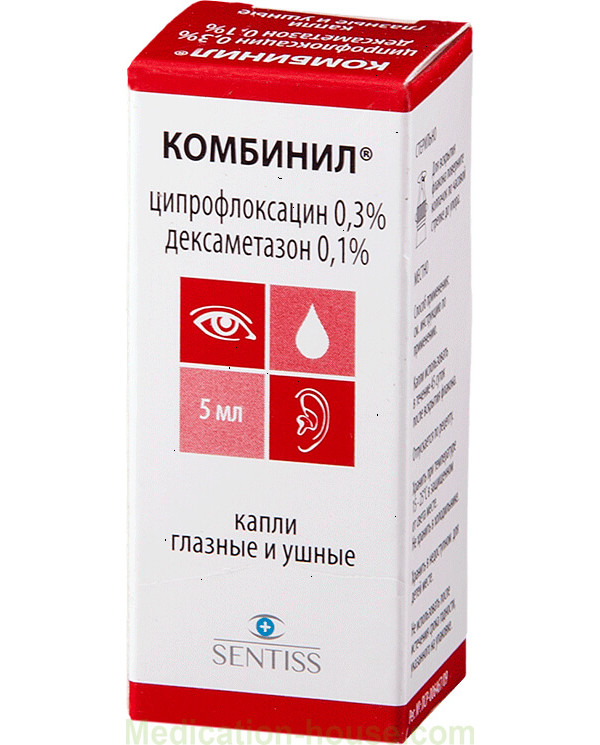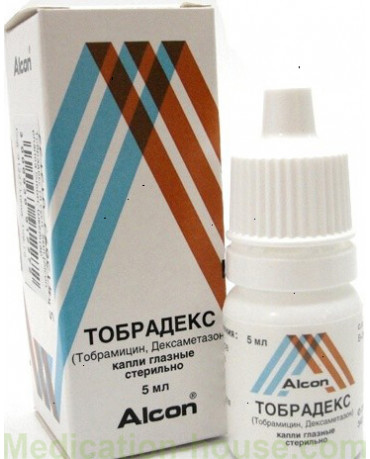Combinil user manual
You can buy Combinil here
Combinil eye drops represent a pharmacological group of ophthalmic drugs that have antimicrobial and anti-inflammatory pharmacological effects. They are prescribed for the treatment of infectious and inflammatory eye pathology. The drug can only be used by adults. It is contraindicated in children and adolescents under 18 years of age, during pregnancy, as well as during breastfeeding.
Composition and form of release
Drops Combinil for eyes, ears have the appearance of a colorless or slightly yellowish solution. The composition includes 2 main components: dexamethasone, ciprofloxacin. Additional components:
water for injections;
benzalkonium chloride;
disodium edetate;
hydrochloric acid;
mannitol;
hydroxypropyl betacyclodextrin.
Pharmachologic effect
The therapeutic effect of Combinil drops is provided by dexamethasone, ciprofloxacin. The first is a synthetic glucocorticosteroid. Its medicinal property is associated with antiproliferative, anti-inflammatory, anti-allergic action. Effects:
reduces the permeability of the walls of blood vessels;
reduces puffiness;
inhibits the process of collagen deposition, the formation of scar tissue;
reduces the activity of phagocytes.
Ciprofloxacin is a broad-spectrum antibiotic of the fluoroquinolone group. Has a bactericidal effect against a large number of gram-negative, gram-positive pathogens:
isherichy;
salmonella;
morganella;
enterobacteriaceae;
shigella;
Proteus;
gardinella;
chlamydia;
staphylococci;
streptococci and many others.
Its action is associated with the inhibition of DNA gyrase in the pathogenic flora, as a result, its replication and synthesis of cellular proteins are disrupted. The antibiotic affects the dormant flora, reproduction.
Pharmacokinetics
When instilled in the eye, ciprofloxacin is distributed throughout its tissues, except for the lens. Its maximum amount in the organ, especially in the anterior chamber, is noted after 30 minutes. The substance enters the general bloodstream, but its concentration is extremely low, therefore it has no clinical significance.
Dexamethasone after instillation into the eye is absorbed into the corneal epithelium, conjunctiva. Inflammation accelerates tissue penetration. Combinil drops contain hydroxypropyl betacyclodextrin, which prolongs the time of drug exposure to tissues.
Indications for use
In ophthalmology, Combinil is prescribed for infectious and inflammatory diseases of the organ of vision, its appendages:
anterior uveitis;
conjunctivitis (acute, subacute);
blepharitis and other eyelid diseases;
keratitis.
The solution is used for prophylaxis, treatment of complications after surgical manipulations on the eyeball, eye injuries. Drops in the ears are prescribed for infectious and inflammatory processes: otitis media of the external, middle ear, including with a shunt of the eardrum.
Instructions for use
For the treatment of ear diseases, 4 drops are shown in the external auditory canal of the diseased ear 2 times a day for 1 week. Procedure for the procedure:
clean the ear with a cotton swab from the earwax that is separated (without pushing the wax inside);
warm the bottle in your hands;
lie on the healthy side;
pull the ear slightly back, up, so that the drops penetrate deeper into the ear canal;
drip the required number of drops;
lie down for 2-3 minutes without changing body position.
To drip drops into the eyes, slightly pull the lower eyelid with a finger, inject the required number of drops into the conjunctival sac (under the eyelid). In order for the drug to be distributed, you need to close your eyes, make circular movements, or quickly blink.
In case of infectious and inflammatory processes in the organ of vision, 1-2 drops are put every 4-6 hours. In the first 1-2 days, it is allowed to apply every 2 hours. Blepharitis, conjunctivitis are treated from 5 days to 2 weeks, keratitis from 14 days to 1 month. For prophylaxis after surgery from 5 to 30 days. If therapy lasts more than 10 days, intraocular pressure must be monitored.
Contraindications
Combinil drops are prohibited for use with:
pregnancy;
under the age of 18;
breastfeeding;
tuberculosis of the eyes;
violation of the integrity of the tympanic membrane;
a viral ear infection;
fungal diseases of the eyes.
Drops are not used with individual intolerance to the components in the composition.
Side effects
Negative eye reactions:
burning;
redness;
horny infiltrates;
foreign body sensation;
conjunctivitis;
swelling of the eyelids;
photophobia;
keratitis;
dry eyes;
blurred or decreased visual acuity;
the appearance of a film before the eyes;
narrowing of the visual fields;
secondary infection of a fungal, bacterial nature;
violation of the integrity of the eyeball;
thinning of the cornea;
development of cataracts.
When used in ENT practice, the following side effects are noted:
congestion in the ear;
pain;
burning;
a feeling of discomfort in the ear.
Other negative symptoms can be a rash on the skin, a violation of taste, and a slowdown in the healing process of tissues.
Overdose
If you exceed the permissible number of drops or the duration of treatment, punctate keratitis, edema, itching of the eyelids, excessive lacrimation, erythema are possible. Drops of Combinil practically do not get into the general blood stream, therefore, no systemic signs of an overdose were identified. There is no specific antidote to the drops. If excess drops get into the eyes, rinse them with running water. When signs of an overdose appear, Combinil is canceled, symptomatic treatment is prescribed.
Special instructions
With purulent eye diseases, corticosteroids can erase signs of a pathological condition. Prolonged use of drops can suppress the immune system, which threatens a secondary infection of the organ of vision. It is also possible to increase intraocular pressure, dysfunction of the optic nerve, decreased vision. Therefore, with prolonged use, it is necessary to control intraocular pressure.
The preservative in the composition affects the quality of contact lenses, this can negatively affect vision. They are removed before instillation, dressed in 15-20 minutes. After use, the bottle is closed to avoid contamination of the solution. Also, do not touch the eyelids, skin with the dispenser, or touch it with your hands. Before instillation in the ears, the ear canal is sanitized with cotton swabs. The bottle with drops is warmed in the hands so as not to cause irritation of the mucous membranes, discomfort. It is forbidden to heat the solution on heating devices.
After instillation in the ears, you need to lie down for about 2 minutes for the drops to drain into the ear canal. To prevent leakage, you can insert a cotton swab to warm the drops in the ear cavity. After instillation in the eyes, visual acuity may temporarily decrease. In this regard, it is not recommended to immediately get behind the wheel, start work that requires clear vision.
Drug interactions
Combinil is found in the blood at a low concentration, so the risk of developing negative drug interactions is extremely small. Possible interaction:
Barbiturates, Carbamazepine, Rifampicin, Phenytoin can enhance the metabolic processes of glucocorticosteroids.
Macrolides, Ketoconazole against the background of Combinil cause an increase in the amount of corticosteroids in the blood.
When the drops are combined with Erythromycin, clearance may increase, the amount of medicinal substances in the blood may decrease.
In combination with other antibacterial drugs, an increase in their action is observed.
The drug interacts well with lactam antimicrobial drugs for the treatment of streptococcal, staphylococcal infections. For the treatment of anaerobic infection, you can combine Combinil with Clindamycin, Metronidazole.
Feedback on the use for ear disease
Marina, 31 years old
Used Combinil for otitis media. I blew in the car when I drove with the window open. In the evening, the ear was blocked, the next day there was pain. I buried it according to the instructions. She was treated for a week, I noticed the effect on the second day, the pain subsided, the congestion disappeared. I was satisfied with the drug.
Ivan, 27 years old
Last year I had a bad flu. Against his background, the right ear became inflamed. At first, it periodically laid, then it began to hurt, a liquid with an unpleasant odor began to stand out. They diagnosed otitis media, prescribed Combinil. Before instillation, they said to clean the ear canal, then drip 4 drops for a week. It became easier on day 2. Within a week I got rid of otitis media.
Reviews on the use for eye diseases
Dmitry, 29 years old
I had bacterial conjunctivitis. He rubbed his eyes with dirty hands at work, the next day his eyes turned red and itchy. I didn't go to the ophthalmologist right away. On the third day, the eye began to hurt, in the morning he could not open it because of some liquid that glued it together. Prescribed drops Combinil. The first 2 days I dripped every 2 hours, then after 6. I cured conjunctivitis in 10 days.
Maria, 31 years old
My aunt used Combinil after eyeball surgery. Prescribed to prevent the development of inflammatory complications, relieve pain. We were satisfied with the product. The pain disappeared in 10-15 minutes, no inflammatory processes appeared.
Storage conditions, shelf life
Drops are stored away from children, direct sunlight at temperatures up to 25 ° C. It is not recommended to store the product in the refrigerator due to the formation of sediment. The combination retains its medicinal properties for 2 years from the date of release. After opening the bottle - 1 month.
Terms of sell
You don't need a prescription to buy Combinil.


